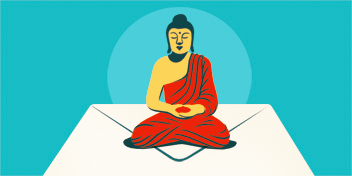First, we bought up all the toilet paper and hand sanitizer. The pasta and baby formula weren’t far behind. Then the waves of backlash, denial, and fear—the spring breakers who vowed to party until the beach bars shuttered, the wealthy trying to place orders for their own personal ventilators, the echochamber of voices saying this is just like the flu. Europe is the current epicenter, with more than 150,000 confirmed cases on Tuesday. In the US, there are cases in all 50 states, and Americans are bracing for the outbreak to peak in the coming weeks, with few assurances that the healthcare system will be able to accommodate everyone.
It’s bad out there, for sure. But good things are happening, too.
Buddhist communities have mobilized, offering alternative ways that we can connect and take care of each other. We talked to a few Buddhist teachers who are offering new approaches and helpful practices in the midst of this time of increased anxiety.
“I think people who have practiced meditation in a retreat context are probably more familiar than many with periods without much sensory stimulation or conversation. Feeling deeply connected to others while all alone is an experience many people describe while on retreat. Well, here we are,” said Sharon Salzberg, a meditation teacher, bestselling author, and cofounder of Insight Meditation Society, in Barre, Massachusetts. (Salzberg kicked off Tricycle’s series of free online practice sessions and will be teaching again on March 31. We’ve also put together a calendar of livestreams and other resources that are available online to everyone.)
“Since I am an older person with a pre-existing bronchial condition, I am truly the person who benefits from others practicing social distancing. I like to think of people doing it out of a sense of lovingkindness. And I think many realize that it is itself a mark of privilege to be able to practice social distancing, while many simply cannot.”
Salzberg recommended a short period of lovingkindness meditation daily, and, outside of our practice, thanking several people and letting them know they are appreciated.
“We are struggling with the fearsome face of interconnection in some ways, and there is a beautiful, positive face as well. Our lives really are connected, and we need one another,” Salzberg said.
“There is no pathological anxiety right now. It’s more like, how much are you experiencing or not experiencing at a given moment in time?” said Mindy Newman, a Buddhist psychotherapist who works with therapy clients in her private practice in New York City. “Some moments, we’re calm and at ease and feel like we’re at home having a snow day. At other times, we’re freaking out.”
Newman switched to seeing her clients online before guidelines encouraging social distancing became law. “In terms of actual practices, I’ve found that there is no one-size-fits-all practice; you should do whatever practice helps you regulate and come into your body.”
“There’s nothing wrong with being afraid—these are scary times. But I don’t think we have to live in the fear,” she shared. Newman suggested being gentle with meditation practice, especially when our minds start flipping to worst-case scenarios.
“Anxiety is very future-oriented and takes us out of whatever is actually going on around us. If a loved one coughs, our mind might automatically snap to a scene where they’re in a hospital on a ventilator. It may be helpful to come out of meditation when you’re experiencing overwhelming thoughts. Open your eyes, look around the room, and maybe open the window and let in some fresh air, feeling the sensation of the air entering your body. Sometimes closing our eyes and focusing really hard can be overstimulating and can exacerbate agitation.”
Newman, who also led a Tricycle live meditation on March 19, was struck by the willingness of the participants to be with their fear. “When someone shared that they were sick and awaiting test results, I was deeply moved. I think it changed something in me, and served as a reminder that there are all of these people out there that I couldn’t see who were really suffering in that moment, hoping to find some relief and comfort.”
Carolyn Gregoire, a writer and coauthor of Wired to Create: Unraveling the Mysteries of the Creative Mind, said that we’re seeing a range of responses to stress surrounding the pandemic, such as “fight or flight,” which can lead to antisocial behavior and panic-buying.
“But there’s another response, too: a ‘tend and befriend’ response, which is thought to be more hard-wired in women, but can be exhibited in either sex. This leads us to nurture and care for others and to act altruistically, with the good of others and the collective in mind,” Gregoire said.
Now isn’t the time to take on big projects, according to Gregoire—instead try to pause and give yourself permission to move at a slower pace. Once the discomfort of being rather than doing wears off, she said, “the inner wellsprings of imagination, inspiration, and wisdom naturally spring forth from the deeper parts of our being.”
Gregoire also suggested working with “creative constraints,” saying that when we have less available, we are “forced to be much more creative.” A few ideas: cook with whatever is in your cupboards, learn how to play guitar through YouTube tutorials, or learn a new skill for an hour each day.
Lauren Krauze, a writing professor and Tricycle contributor who lives in New York City, launched Read to Me earlier this month in direct response to the pandemic. Krauze said that during a difficult time in 2016, she had asked her close friends to send audio recordings of themselves reading a text they found meaningful.
“I got about two dozen recordings—book chapters, poems, articles, essays, and even recipes. When I found myself awake in the middle of the night, I would listen to these recordings and feel comforted. I still have the recordings today and listen to them regularly,” Krauze said.
These audio recordings inspired Krauze to launch Read to Me in mid-March. Those who sign up for this “one-to-one read aloud program” will receive a short audio recording of Krauze or another volunteer reading a short text and explaining what it means to them.
“I have always found that reading—and being read to—can be very soothing” and like a form of meditation, Krauze said.
“The Buddhist teaching I discover anew with every Read to Me exchange is just how profoundly interconnected we are, how much we have in common despite geographical barriers and cultural differences,” Krauze said. This program has also reminded me how interconnectedness can foster comfort and ease suffering in deeply uncertain times.
♦
Has your sangha launched a new online program in recent weeks? If you know of an event or resource that is not included on on our list, please email us at editorial@tricycle.org and include “Online Meditation Calendar” in the subject line.
Thank you for subscribing to Tricycle! As a nonprofit, we depend on readers like you to keep Buddhist teachings and practices widely available.

